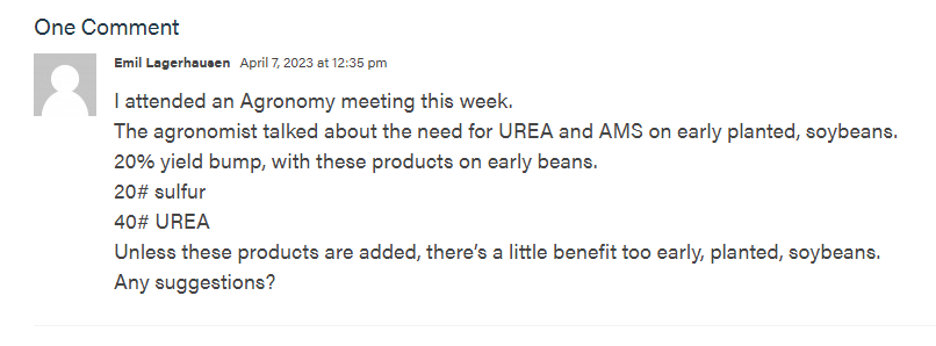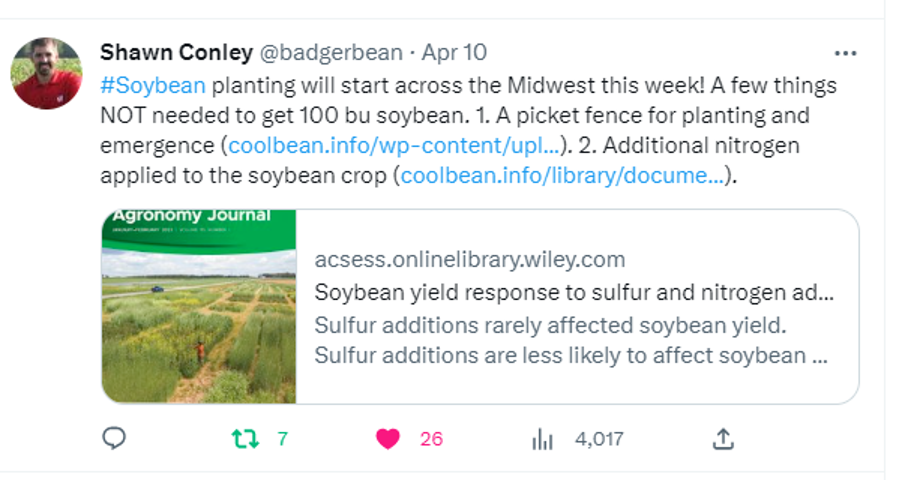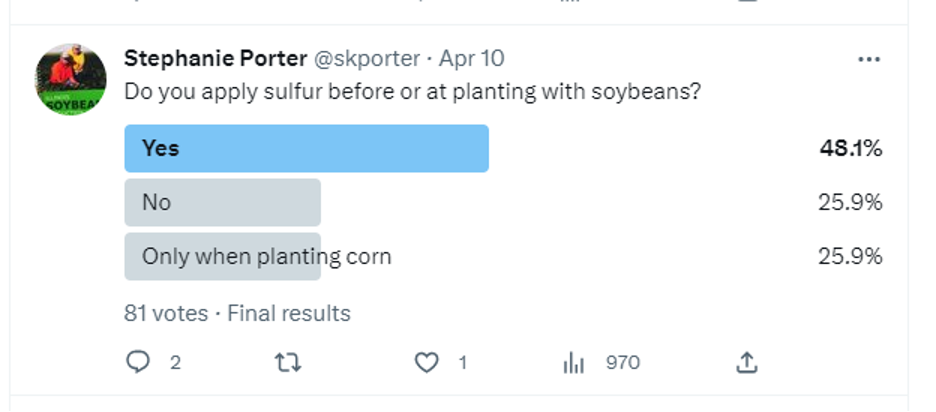Last week I received a comment from a farmer named Emil after he had read by my blog, “Early Soybean Planting in April: The Why and How.” Here was his comment and question:

Soon after, I read this tweet from Dr. Shawn Conley as if he had just seen Emil’s comment above.

Conley directed everyone to an Agronomy Journal article entitled, “Soybean Yield Response to Sulfur and Nitrogen Additions Across Diverse U.S. Environments.” This study consisted of data from 52 sites in 10 states over a 2-year (2019 and 2020) period to evaluate the effect of Sulfur (S) and Nitrogen (N) on soybean yield in diverse environments across the U.S.
- Three S rates of 11, 22, and 33 kg S ha−1 were broadcasted by hand at planting using two sources (ammonium sulfate [AMS] and calcium sulfate [CaSO4]).
- Urea was applied at 10, 20, and 29 kg N ha−1to equal that supplied by AMS to examine the impact of N on soybean yield.
- A zero-fertilizer control treatment was also included.
Prior to fertilization, they collected soil samples and later gathered grain yield when soybeans reached the R8 soybean growth stage. The samples were analyzed to further understand in what environments soybeans might respond to the addition of S. The results of this study revealed that soil and environmental factors are poor indicators of yield response with the addition of S and N. The conclusions of this study were as follows:
“Although the focus of this research was to observe S fertilizer effects, treatments of N agree with current research that N additions may improve yield. Further research is necessary to understand the interactive effect of N, P, S, Mn, and Zn in the soil and the soybean plant and to better understand what agronomic, soil, or other environmental factors may cause N or S fertility additions to be consistently warranted. As soybean yields continue to increase, without S additions, soils will become depleted and S additions may prove to be more profitable.”
I recently ran a poll on Twitter to see how many were applying sulfur before soybeans and it appears that it is becoming more common practice.

When comes to adding sulfur and nitrogen before soybeans, what is next in Illinois regarding research? The Illinois Soybean Association check-off program is funding a research project called, “Adaptive Management for Maximizing Soybean Production Following Cereal Rye Production.” This project is headed up by Dr. Shalamar Armstrong, Purdue University, Dr. Giovani Preza-Fontes, Assistant Professor and Field Crops Extension Agronomist, University of Illinois, and Dr. Shaun Casteel, Associate Professor of Agronomy, Purdue University. This research will help answer the following questions:
- Does supplemental N and S impact soybean yield response?
- How does cereal rye influence soil N and S availability and uptake by soybean after termination?
While the impact of cereal rye on corn production has been well studied, there is minimal research around managing soybeans after a cereal rye cover crop. Little is known about how cereal rye affects soil N and S availability for soybean uptake after cereal rye termination. In addition, there are questions about soybean yield response to supplemental N and S fertilization.
This research will be conducted at the South Farm in Urbana as well as a farm in Effingham County. However, this is not just any farm in Effingham County…. this is Emil’s farm, the farmer that originally asked for suggestions regarding adding N and S before planting early soybeans. They are currently broadcasting 40 lbs. of N/acre using urea and 20 lbs. S/acre using pelletized gypsum on his farm. Remain on the edge of your tractor seat to hear the results of these trials later this year!




 and then
and then